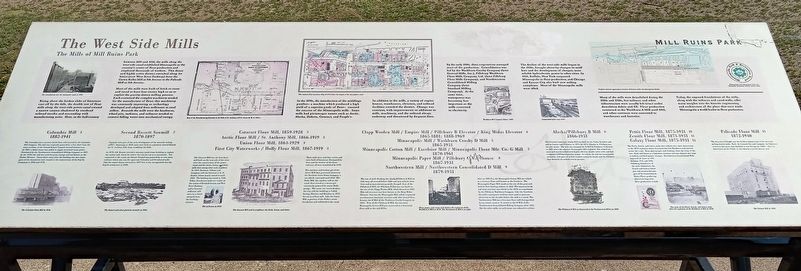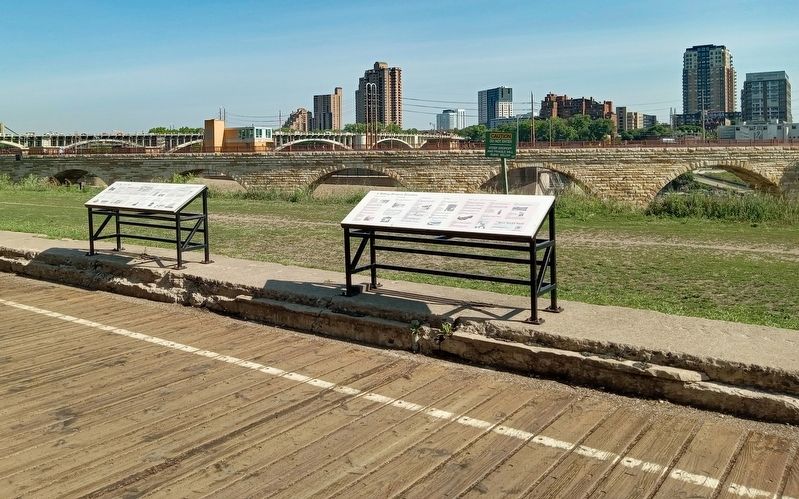Downtown East in Minneapolis in Hennepin County, Minnesota — The American Midwest (Upper Plains)
The West Side Mills
The Mills of Mill Ruins Park
The rail platform over the waterpower canal in 1900.
Rising above the broken slabs of limestone cast off by the falls, the double row of flour mills along the west-side power canal created a narrow canyon shadowed by overhead railroad trestles and resounding with manufacturing noise. Here, in the half-century between 1880 and 1930, the mills along the west-side canal established Minneapolis as the country's center of flour production and employed thousands of workers. This dense and highly active district stretched along 1st Street (now West River Parkway) from the Crown Roller Mill at 5th Avenue to the Palisade Mill at 8th Avenue.
Most of the mills were built of brick or stone and stood at least four stories high so as to exploit the gravity-driven milling process. Each contained the complex machinery needed for the manufacture of flour; this machinery was constantly improving as technology developed and adapted from millstones to steel rollers. Beneath the mills were the headraces, wheel pits, turbines, and tailraces needed to convert falling water into mechanical energy.
Map of the Manufacturing Interests at the Falls of St. Anthony (1873), drawn by M.A. Fuller.
The Sanborn Fire Insurance Map of 1912 shows the length of the waterpower canal.
In the 1870s, the introduction of the middlings purifier– a machine which produced a high yield of a superior grade of flour– ensured the success of Minneapolis mills. Some mills had picturesque names such as Arctic, Alaska, Dakota, Cataract, and People's.
In addition to the mills, a variety of engine houses, warehouses, elevators, and railroad facilities crowded the district. Change was constant, with improvements or additions to mills, machinery, and the railroad always underway and threatened by frequent fires.
By the early 1900s, three corporations managed most of the production. Consolidation was led by the Washburn-Crosby Company (later General Mills, Inc.), Pillsbury Washburn Flour Mills Company, Ltd. (later Pillsbury Flour Mills Company), and Northwestern Consolidated Milling Company (later Standard Milling Company). At the same time, waterpower was becoming less important as the mills converted to electricity.
The decline of the west-side mills began in the 1920s, brought about by changes in tariff laws and the development of cheaper, more reliable hydroelectric power in other cities. In 1930, Buffalo, New York surpassed Minneapolis in flour production, and Chicago and Kansas City also built new milling complexes. Most of the Minneapolis mills were idled.
Washburn Mill Company Poster, 1889.
Demolished mills
circa 1930.
Numbers indicate approximate location of historic mills (see descriptions below)
Many of the mills were demolished during the 1920s and 1930s, but tailraces and other infrastructure were usually left intact under demolition debris and fill. Flour production continued at the Washburn A Mill until 1965, and other survivors were converted to warehouses and factories.
Today, the exposed foundations of the mills, along with the tailraces and canal walls, offer many insights into the historic engineering and architecture of the place that once made Minneapolis a world leader in flour production.
1882-1941
The Columbia was a six-story brick flour mill erected by the Columbia Mill Company. The mill was originally powered by a line shaft from the water turbines of the Second Bassett Sawmill, located downstream. In 1889, a boiler house was added to supply increased steam power. Purchased by the Northwestern Consolidated Milling Company in 1891, by the 1930s the mill was used for grain storage and was known as the Harbor Elevator. About thirty years after the building was torn down, parts of the foundation were reused in the construction of the Fuji-Ya restaurant in 1968 and 1974.
The Columbia Flour Mill in 1914.
1870-1897
Sawmills were part of the development of the west-side milling district. Beginning in 1858, some were built on a platform erected behind the St. Anthony Falls dam, straddling the Falls.
In 1870, J.B. Bassett erected a two-story wood frame building to replace the earlier mill, which he sold to the city for use as a waterworks. Not connected to the canal, the Bassett Sawmill was powered by its own water turbines which also ran the upstream Columbia and Occidental mills. only the engine house survived an 1897 fire; it was incorporated into the Fuji-Ya restaurant in 1968.
The Bassett and other platform sawmills in 1860.
3: Arctic Flour Mill / St. Anthony Mill, 1866-1919
3: Union Flour Mill, 1863-1929
3: First City Waterworks / Holly Flour Mill, 1867-1919
The Cataract Mill was the first flour mill built on the west side of the river after the construction of the power canal, and the Arctic, Union, and Holly mills were among other early neighbors. In 1869, Eastman, Gibson and Company sold the Cataract to R.D. Barber, whose family owned it until 1923. The building was razed in 1928. Today, foundation walls are visible at the corner of Portland Avenue and West River Parkway, and a Cataract millstone still rests on a lintel salvaged from the building exterior.
The millstone in 2002.
The Cataract Mill and its neighbors, the Holly, Union, and Arctic.
These mills were each four stories and were built of limestone. Decimated by fires and the decline of the flour industry, all were demolished by 1930.
The raceways and turbine pit of the Arctic Mill then generated electricity for Northern States Power Company, a use which continued until 1960. The Holly Mill, the smallest mill on the canal, first served as a municipal waterworks powered by rotary Holly pumps. The name was retained when the city sold the building to Cahill, Loring, Fletcher and Hineline in 1872 for use as a flour mill. Like the Union Mill, a portion of the Holly's south foundation wall still borders the canal.
1865-1881; 188-1969
5: Minneapolis Mill / Washburn Crosby D Mill
1865-1931
7: Minneapolis Cotton Mill / Excelsior Mill / Minneapolis Flour Mfr. Co. G Mill
1870-1961
8: Minneapolis Paper MIll / Pillsbury C Warehouse
1867-1931
9: Northwestern Mill / Northwestern Consolidated D Mill
1879-1931
The row of mills flanking the Alaska/Pillbury B Mill (at left) were all erected before 1880 and were rebuilt after fires and as manufacturing needs changed. East of the Pillsbury B Mill, the Pillsbury B Elevator was built on the site of the Clapp Woolen Mill, which burned in 1881. This tall structure was later known as the King Midas Elevator. Next was the Minneapolis Mill, which originated as a four-story limestone structure and, after several fires, became the D Mill of the Washburn Crosby Company in 1893. West of the Pillsbury B Mill, the two-story Minneapolis Cotton Mill was converted to a four-story flour mill in the mid-1870s.
After an 1881 fire, the Minneapolis Cotton Mill was rebuilt as a six-story flour mill known as the Excelsior. The Minneapolis Paper Mill stood on the site of the grist mill built by Fort Snelling soldiers in 1823. The two-story brick and stone structure was rebuilt in the 1890s as a warehouse by the Pillsbury Washburn Company. Like the Excelsior, the mill's waterpower turbines were used to generate electricity in the decades before the mill was razed. The Northwestern Mill was a five-story flour mill distinguished by an ornate cornice. It served as the D Mill of the Northwestern Consolidated Milling Company after 1891; like the other mills, its early name was reduced to a letter.
1866-1931
The five-story limestone Alaska Mill was built by the Taylor Brothers and sold to Garner and Pillsbury in 1870; by 1874, Charles A. Pillsbury was the sole owner. The mill was renamed the B Mill by Pillsbury. It burned in 1881 when the adjacent Minneapolis Mill exploded. The rebuilt six-story mill was furnished with highly efficient double roller mills and had a reported 4,000-barrel-per-day output. As rebuilt, the mill was exceptionally attractive, with pairs of arched windows across the façade and the Pillsbury logo beneath an arched central parapet.
The Pillsbury B Mill as illustrated in the Northwestern Miller in 1886.
11: Zenith Flour Mill, 1871-1931
12: Galaxy Flour Mill, 1875-1931
The Pettit, Zenith, and Galaxy mills were rebuilt after their destruction in the 1878 explosion which destroyed the first Washburn mill directly across the canal. Many photographs and drawings show the ruins of the trio. Each mill began as a limestone structure and was adapted over time to milling and hydropower changes. Northwestern Consolidated Mills acquired all three in 1891. Between 1932 and 1960, following demolition of the mills themselves, the Zenith and Galaxy wheel pits and raceway became part of the Consolidated Hydro Plant, producing electricity long after flour production ceased.
The ruins of the Pettit, Zenith, and Galaxy mills after the explosion of the Washburn A Mill in 1878.
1872-1940
The four-story Palisade was the farthest downstream of the west-side milling district mills. Built by Leonard Day and Company, the limestone structure was more than doubled in size during the 1880s. After its demolition in the 1930s, its site became a gravel storage yard.
The Palisade Mill in 1884.
Erected by Minneapolis Park and Recreation Board.
Topics. This historical marker is listed in this topic list: Industry & Commerce. A significant historical year for this entry is 1859.
Location. 44° 58.764′ N, 93° 15.407′ W. Marker is in Minneapolis, Minnesota, in Hennepin County. It is in Downtown East. Marker is on West River Parkway, on the right when traveling west. The marker is directly across from the rear entrance to Mill City Museum. Touch for map. Marker is at or near this postal address: 700 West River Parkway, Minneapolis MN 55401, United States of America. Touch for directions.
Other nearby markers. At least 8 other markers are within walking distance of this marker. A Milling District Timeline (here, next to this marker); Washburn Mill "A" Memorial (a few steps from this marker); Did You Notice a Plaque Outside This Entrance? (within shouting distance of this marker); The Washburn A Mill (within shouting distance of this marker); What is Urban Archaeology? (within shouting distance of this marker); Beauty and Nature at the Falls (about 300 feet away, measured in a direct line); Tailrace Skyline (about 300 feet away); Bridges of the St. Anthony Falls Area (about 400 feet away). Touch for a list and map of all markers in Minneapolis.
Credits. This page was last revised on October 30, 2023. It was originally submitted on October 24, 2023, by McGhiever of Minneapolis, Minnesota. This page has been viewed 81 times since then and 28 times this year. Photos: 1, 2. submitted on October 24, 2023, by McGhiever of Minneapolis, Minnesota. • J. Makali Bruton was the editor who published this page.

